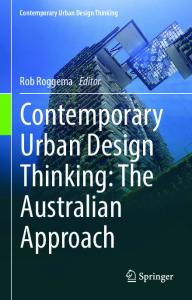Design Thinking and the Digital Ecosystem
Because design thinking is contextual, insomuch as it varies depending on the tools being used and the environments that support it, there is a need to understand the cognitive impacts of any new platforms that are developed. The focus of this chapter is
- PDF / 6,356,450 Bytes
- 253 Pages / 453.543 x 683.15 pts Page_size
- 115 Downloads / 368 Views
ign Thinking: Creativity, Collaboration and Culture
Design Thinking: Creativity, Collaboration and Culture
Ju Hyun Lee Michael J. Ostwald Ning Gu •
•
Design Thinking: Creativity, Collaboration and Culture
123
Ju Hyun Lee UNSW Built Environment University of New South Wales Sydney, NSW, Australia
Michael J. Ostwald UNSW Built Environment University of New South Wales Sydney, NSW, Australia
Ning Gu UniSA Creative University of South Australia Adelaide, SA, Australia
ISBN 978-3-030-56557-2 ISBN 978-3-030-56558-9 https://doi.org/10.1007/978-3-030-56558-9
(eBook)
© Springer Nature Switzerland AG 2020 This work is subject to copyright. All rights are reserved by the Publisher, whether the whole or part of the material is concerned, specifically the rights of translation, reprinting, reuse of illustrations, recitation, broadcasting, reproduction on microfilms or in any other physical way, and transmission or information storage and retrieval, electronic adaptation, computer software, or by similar or dissimilar methodology now known or hereafter developed. The use of general descriptive names, registered names, trademarks, service marks, etc. in this publication does not imply, even in the absence of a specific statement, that such names are exempt from the relevant protective laws and regulations and therefore free for general use. The publisher, the authors and the editors are safe to assume that the advice and information in this book are believed to be true and accurate at the date of publication. Neither the publisher nor the authors or the editors give a warranty, expressed or implied, with respect to the material contained herein or for any errors or omissions that may have been made. The publisher remains neutral with regard to jurisdictional claims in published maps and institutional affiliations. This Springer imprint is published by the registered company Springer Nature Switzerland AG The registered company address is: Gewerbestrasse 11, 6330 Cham, Switzerland
Preface
In its simplest form, “design thinking” refers to the reasoning processes that occur during the act of creating a product. It encapsulates the cognitive strategies and behaviours of people who are engaged in developing innovative solutions to problems, or identifying new opportunities in a complex marketplace or ecosystem. Importantly, design thinking offers a valuable counterpoint to “scientific thinking”. The former is typically characterised as user-centred, inventive and even productively disruptive, while the latter is regarded as methodical, logical and reductive. Despite the simplicity of this characterisation, design thinking is fundamentally concerned with developing creative or original responses. At a time when the world’s headlines are dominated by grand challenges such as ecological dilemmas, economic crises and resource shortages, the capacity to develop innovative solutions to problems and sometimes even re-define the problems has never been so critical. Because design thinking is primarily used to solve “real-world”, “ill
Data Loading...











